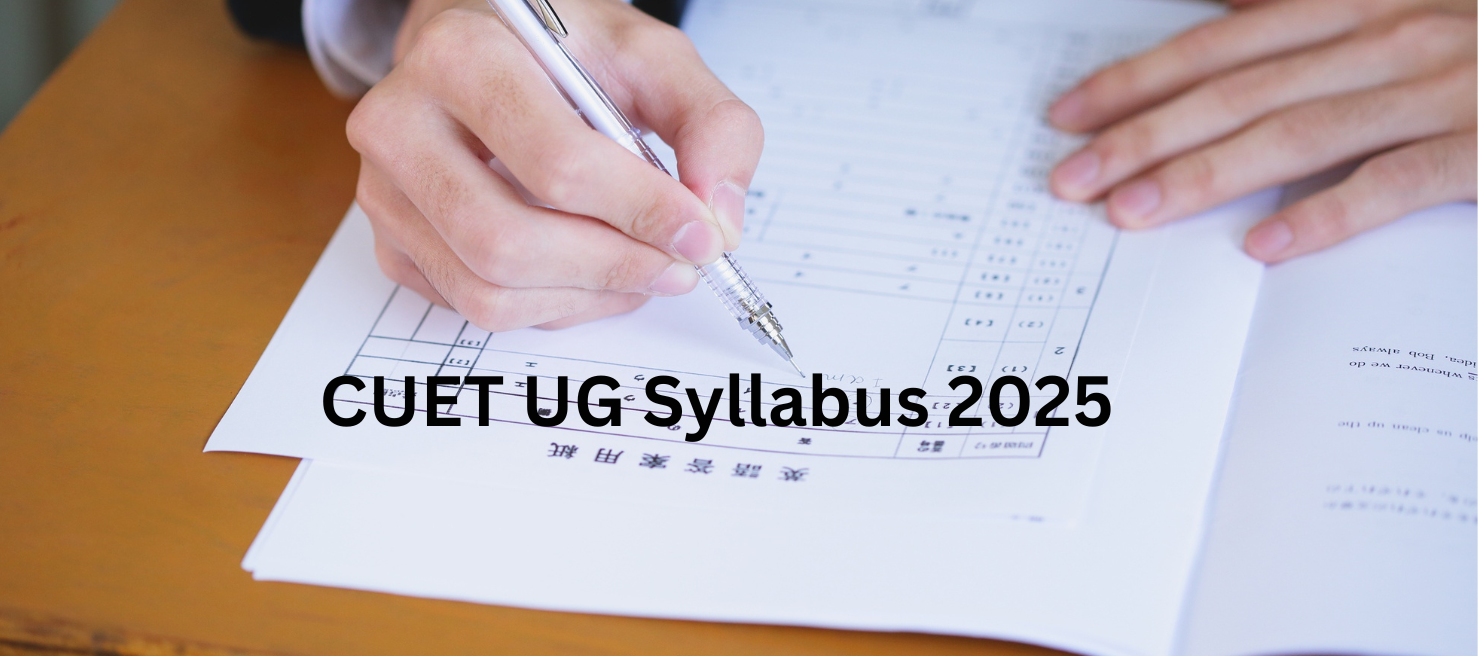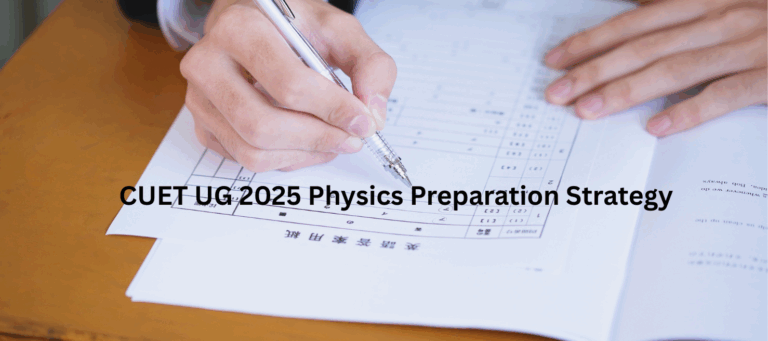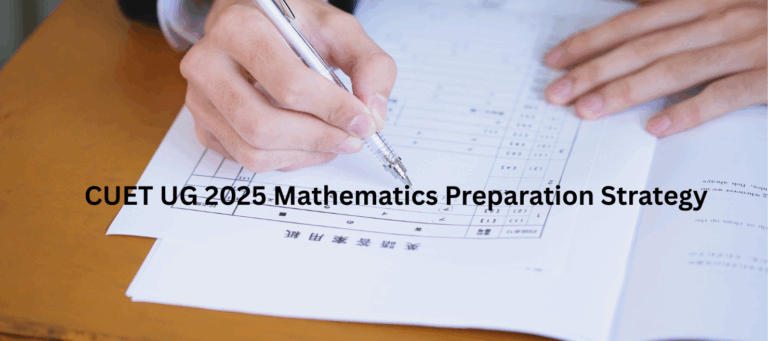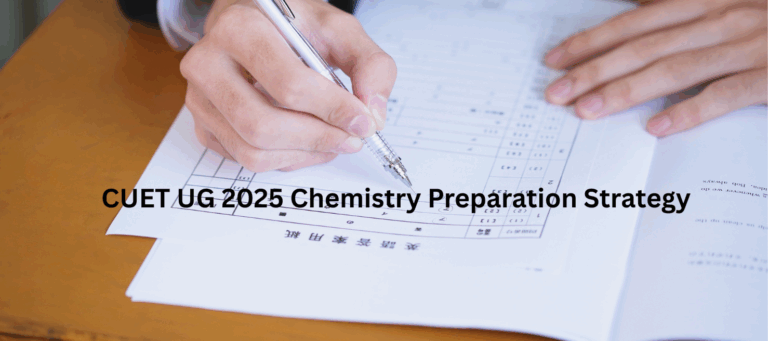
The Common University Entrance Test, conducted by the National Testing Agency, is a national-level entrance examination. The CUET UG exam allows candidates to take admissions to various central, state, and private universities across India. The CUET UG 2025 exam will be held from May 13th to June 3rd, 2025. Candidates preparing for the CUET UG exam are advised to understand the CUET UG exam pattern to familiarise themselves with the examination process.
Candidates preparing for the exam must follow several steps, starting from the CUET UG 2025 registration, accessing the CUET UG Admit card, appearing for the exam and the counselling process. But with the right preparation strategy, you can confidently succeed. Candidates appearing for the exam are advised to prepare and adhere to a strict preparation strategy to succeed in the CUET exam. This detailed blog will cover the CUET UG Syllabus 2025, which will include essential topics from the Physics, Chemistry, and Mathematics subjects.
Understanding the CUET Exam Pattern
The CUET UG examination is conducted across three sections, and candidates are tested across three skills, namely, language, aptitude, and domain-specific skills. Candidates are allowed to complete each paper within the limited time frame of 60 minutes. Check the details of the CUET exam pattern below:
| Section | No of Questions | Duration of the Exam | Questions Type |
| Section IA- Language | 50 Questions | 60 Minutes for Each Subject | Candidates’ language skills will be assessed through several sections, such as reading comprehension, vocabulary, etc. |
| Section II- Domain Specific | 50 Questions | Domain-specific test based on the Class 12th syllabus. | |
| Section III- General Test | 50 Questions | This section will evaluate knowledge of General Awareness, Current Affairs, Mental Ability, Numerical Skills, Quantitative Reasoning (covering basic math concepts from arithmetic, algebra, geometry, and mensuration up to Grade 8), along with Logical and Analytical Reasoning. |
Previous Year Questions for Science Students
Previous years’ questions are an important source for your preparation. Students can understand the difficulty level of the questions asked in the exam, topics that are often asked in the exam and the level of preparation required to tackle the questions asked in the exam. Check the subject-wise previous year questions asked in the CUET exam here:
| Subject | PYQs |
| CUET Physics PYQ | Download here: 2024 Download here: 2023 Download here: 2022 |
| Mathematics | Download here: 2024 Download here: 2023 Download here: 2022 |
| Chemistry | Download here: 2024 Download here: 2023 Download here: 2022 |
CUET 2025 Syllabus for Science: Physics, Mathematics, Chemistry
It is important to understand the CUET Syllabus for science students, for each subject, to understand the types of questions asked and the amount of preparation you require to tackle the questions in the exam. Understanding the CUET syllabus also helps you strategise your exam to comprehensively cover the complete CUET syllabus and score high in the exam. Check the CUET syllabus for science students below:
CUET 2025 Subject Weightage
Understanding subject-wise weightage is essential to target the most critical topics and boost your score. Whether focusing on Physics, Chemistry, or Mathematics, analysing previous year trends helps you prepare strategically. With College Dost, you can easily access detailed CUET 2025 Weightage and get clarity on which chapters matter the most. Download the Weightages from the links below
| Subject | Weightage |
| Physics | Download here |
| Mathematics | Download here |
| Chemistry | Download here |
CUET Physics Syllabus
Check the CUET syllabus for the Physics subject here:
| Unit | Syllabus |
| Unit 1: Electrostatics | Electric charges and their conservation, Coulomb’s law – force between two-point charges, forces between multiple charges, superposition principle and continuous charge distribution. Electric field, electric field due to a point charge, electric field lines, electric dipole, electric field due to a dipole, torque on a dipole in a uniform electric field. Electric flux, statement of Gauss’s theorem and its applications to find field due to infinitely long straight wire, uniformly charged infinite plane sheet and uniformly charged thin spherical shell (field inside and outside). Electric potential, potential difference, electric potential due to a point charge, a dipole and system of charges, equipotential surfaces, electrical potential energy of a system of two point charges and of electric dipoles in an electrostatic field. Conductors and insulators, free charges and bound charges inside a conductor, dielectrics and electric polarisation, capacitors and capacitance, combination of capacitors in series and in parallel, capacitance of a parallel plate capacitor with and without dielectric medium between the plates, energy stored in a capacitor. |
| Unit 2: Current Electricity | Electric current, flow of electric charges in a metallic conductor, drift velocity and mobility, and their relation with electric current, Ohm’s law, electrical resistance, V-I characteristics (linear and non-linear), electrical energy and power, electrical resistivity and conductivity, temperature dependence of resistance. Internal resistance of a cell, potential difference and emf of a cell, combination of cells in series and in parallel. Kirchhoff’s laws, Wheatstone bridge. |
| Unit 3: Magnetic Effects of Current and Magnetism | Need for displacement current. Electromagnetic waves and their characteristics (qualitative ideas only). Transverse nature of electromagnetic waves. Electromagnetic spectrum (radio waves, microwaves, infrared, visible, ultraviolet, x-rays, gamma rays), including elementary facts about their uses. |
| Unit 4: Electromagnetic Induction and Alternating Currents | Electromagnetic induction, Faraday’s law, induced emf and current, Lenz’s law, eddy currents. Self and mutual inductance. Alternating currents, peak and rms value of alternating current/voltage, reactance and impedance, LC oscillations (qualitative treatment only), LCR series circuit, resonance, power in AC circuits, wattless current. AC generator and transformer. |
| Unit 5: Electromagnetic Waves | Reflection of light, spherical mirrors, and the mirror formula. Refraction of light, total internal reflection and its applications, optical fibres, refraction at spherical surfaces, lenses, thin lens formula, lens-maker’s formula. Magnification, power of a lens, combination of thin lenses in contact, combination of a lens and a mirror. Refraction and dispersion of light through a prism. Scattering of light – blue colour of the sky and reddish appearance of the sun at sunrise and sunset. Optical instruments: microscopes and astronomical telescopes (reflecting and refracting) and their magnifying powers. Wave optics: wavefront and Huygens’ principle, reflection and refraction of plane wave at a plane surface using wavefronts. Proof of laws of reflection and refraction using Huygens’ principle. Interference, Young’s double hole experiment and expression for fringe width, coherent sources and sustained interference of light. Diffraction due to a single slit. Polarisation, plane polarised light. |
| Unit 6: Optics | Alpha-particle scattering experiment, Rutherford’s model of an atom, Bohr model, energy levels, hydrogen spectrum. Composition and size of nucleus, atomic masses, isotopes, isobars, isotones. Radioactivity – alpha, beta and gamma particles/rays and their properties. Mass-energy relation, mass defect, binding energy per nucleon and its variation with mass number, nuclear fission and fusion. |
| Unit 7: Dual Nature of Matter and Radiation | Photoelectric effect, Hertz and Lenard’s observations, Einstein’s photoelectric equation – particle nature of light. Matter waves – wave nature of particles, de Broglie relation. |
| Unit 8: Atoms and Nuclei | Alpha-particle scattering experiment, Rutherford’s model of atom, Bohr model, energy levels, hydrogen spectrum. Composition and size of nucleus, atomic masses, isotopes, isobars, isotones. Radioactivity – alpha, beta and gamma particles/rays and their properties. Mass-energy relation, mass defect, binding energy per nucleon and its variation with mass number, nuclear fission and fusion. |
| Unit 9: Electronic Devices | Energy bands in solids (qualitative ideas only), conductors, insulators and semiconductors, semiconductor diode – I-V characteristics in forward and reverse bias, diode as a rectifier. |
CUET Chemistry Syllabus 2025
Check the CUET syllabus for the Chemistry subject here:
| Unit | Syllabus |
| Unit I: Solutions | Types of solutions, expression of concentration of solutions of solids in liquids, solubility of gases in liquids, solid solutions, Raoult’s law, colligative properties such as relative lowering of vapour pressure, elevation of boiling point, depression of freezing point, and osmotic pressure. Determination of molecular masses using colligative properties, abnormal molecular mass, and Van’t Hoff factor. |
| Unit II: Electrochemistry | Redox reactions, EMF of a cell, standard electrode potential, Nernst equation and its application to chemical cells, relation between Gibbs energy change and EMF of a cell. Conductance in electrolytic solutions, specific and molar conductivity, variations of conductivity with concentration, Kohlrausch’s law, electrolysis and law of electrolysis (elementary idea), dry cell, electrolytic cells and Galvanic cells, lead accumulator, fuel cells, and corrosion. |
| Unit III: Chemical Kinetics | Rate of a reaction (average and instantaneous), factors affecting rate of reaction including concentration, temperature and catalyst, order and molecularity of a reaction, rate law and specific rate constant. Integrated rate equations and half-life for zero and first order reactions, concept of collision theory (elementary idea without mathematical treatment), activation energy and Arrhenius equation. |
| Unit IV: d and f Block Elements | General introduction, electronic configuration, occurrence and characteristics of transition metals, general trends in properties of the first row transition metals, including metallic character, ionisation enthalpy, oxidation states, ionic radii, colour, catalytic property, magnetic properties, interstitial compounds, and alloy formation. Preparation and properties of potassium dichromate (K₂Cr₂O₇) and potassium permanganate (KMnO₄). Lanthanoids, including electronic configuration, oxidation states, chemical reactivity, lanthanoid contraction and its consequences. Actinoids, including electronic configuration, oxidation states, and comparison with lanthanoids. |
| Unit V: Coordination Compounds | Coordination compounds including introduction, ligands, coordination number, colour, magnetic properties and shapes, IUPAC nomenclature of mononuclear coordination compounds. Bonding theories including Werner’s theory, Valence Bond Theory (VBT), and Crystal Field Theory (CFT). Structure and stereoisomerism, and the importance of coordination compounds in qualitative analysis, extraction of metals and biological systems. |
| Unit VI: Haloalkanes and Haloarenes | Amines including nomenclature, classification, structure, methods of preparation, physical and chemical properties, uses, and identification of primary, secondary and tertiary amines. Diazonium salts, including preparation, chemical reactions, and importance in synthetic organic chemistry. |
| Unit VII: Alcohols, Phenols and Ethers | Nomenclature, nature of carbon–halogen (C–X) bond, physical and chemical properties, and optical rotation. Mechanism of substitution reactions in haloalkanes. In haloarenes, the nature of the C–X bond and substitution reactions with directive influence of halogen in monosubstituted compounds. Uses and environmental effects of compounds like dichloromethane, trichloromethane, tetrachloromethane, iodoform, freons, and DDT. |
| Unit VIII: Aldehydes, Ketones and Carboxylic Acids | Aldehydes and ketones, including nomenclature, nature of the carbonyl group, methods of preparation, physical and chemical properties, mechanism of nucleophilic addition, reactivity of alpha hydrogen in aldehydes, and uses. Carboxylic acids, including nomenclature, acidic nature, methods of preparation, physical and chemical properties, and uses. |
| Unit IX: Amines | Amines: Nomenclature, classification, structure, methods of preparation, physical and chemical properties, uses, identification of primary, secondary and tertiary amines. Diazonium salts: Preparation, chemical reactions and importance in synthetic organic chemistry. |
| Unit X: Biomolecules | Carbohydrates, including classification into aldoses and ketoses, monosaccharides such as glucose and fructose, D-L configuration, oligosaccharides such as sucrose, lactose, and maltose, polysaccharides such as starch, cellulose and glycogen, and the importance of carbohydrates. Proteins, including elementary ideas of amino acids, peptide bond, polypeptides, proteins, and the primary, secondary, tertiary and quaternary structures of proteins (qualitative idea only), denaturation of proteins, and enzymes. Hormones include elementary ideas (excluding structure), vitamins, classification, and functions—nucleic acids, including DNA and RNA. |
CUET Maths Syllabus 2025
Check your CUET Maths syllabus here:
| Section A1: Common Topics (Mathematics & Applied Mathematics) | |
| Topic | Subtopics |
| Algebra | Matrices and types, Equality, Transpose, Symmetric & Skew-Symmetric Matrices, Algebra of Matrices, Determinants, Inverse of Matrix, Solving Simultaneous Equations using Matrix Method |
| Calculus | Higher Order Derivatives, Increasing/Decreasing Functions, Maxima and Minima |
| Integration & Applications | Indefinite & Definite Integrals, Application of Integration as Area under Curve |
| Differential Equations | Order and Degree, Solution of Variable Separable Type |
| Probability Distributions | Concept of Random Variable |
| Linear Programming | Graphical Method for Two Variables, Feasible & Infeasible Regions, Optimal Feasible Solutions |
| Section B1: Mathematics | |
| Topic | Subtopics |
| Relations & Functions | Types of Relations, One-One and Onto Functions |
| Inverse Trigonometric Functions | Definitions, Graphs, Domain & Range |
| Algebra | Matrices: Concepts, Operations, Invertibility; Determinants: Evaluation, Adjoint, Inverse, Solving Equations |
| Calculus | Continuity, Differentiability, Derivatives (incl. Inverse Trig., Exponential, Logarithmic), Applications (Maxima, Minima), Integrals (methods & types), Applications of Integrals, Differential Equations |
| Vectors & 3D Geometry | Vectors: Types, Dot & Cross Product; 3D Geometry: Direction Ratios, Lines, Shortest Distance |
| Linear Programming | Graphical Method, Constraints, Optimal Solution |
| Probability | Conditional Probability, Bayes Theorem, Random Variables, Total Probability |
| Section B2: Applied Mathematics | |
| Topic | Subtopics |
| Numbers, Quantification & Numerical Apps | Modulo Arithmetic, Congruence, Allegation, Pipes, Streams, Games, Inequalities |
| Algebra | Matrices, Transpose, Determinant, Inverse, Solving Simultaneous Equations |
| Calculus | Derivatives, Marginal Cost/Revenue, Maxima/Minima, Integration, Applications (incl. Consumer/Producer Surplus), Differential Equations & Applications (Growth/Decay) |
| Probability Distributions | Random Variable, Expectation, Variance, Binomial, Poisson & Normal Distributions |
| Index Numbers & Time Series | Components, Trends, Methods of Measurement |
| Inferential Statistics | Sampling, Parameter vs. Statistic, Central Limit Theorem, t-Test (One Sample, Two Groups) |
| Financial Mathematics | Perpetuity, Sinking Funds, EMI, Returns, CAGR, Depreciation |
| Linear Programming | Concepts, Formulation, Graphical Solutions, Feasibility & Optimisation |
CUET UG 2025 Subject-Wise Important Topics
The CUET UG 2025 exam requires a thorough understanding of key subjects to excel. Focusing on important topics within each subject can significantly enhance preparation and performance.
Physics
In CUET 2025, the physics subject is worth 250 marks, and candidates are given 60 minutes to appear for the exam. Here are some of the important topics for CUET 2025 Physics.
| Unit | Important Topics(No of Questions) |
| Electrostatistics | Electrostatic Potential and Capacitance (3) Electric Charge and Electric Field(7) |
| Current Electricity | Current Electricity(6) |
| Magnetic Effects of Current and Magnetism | Magnetism and Matter.(5) Moving charges and Magnetism.(5) |
| Electromagnetic Induction and Magnetic Currents | Alternating Currents.(4) Electromagnetic Induction.(1) |
| Electromagnetic waves | Electromagnetic Waves(5) |
| Optics | Ray optics and Wave optics(4) |
| Dual nature of matter and Radiation | Dual nature of matter(2) |
| Atoms and Nuclei | Atoms and Nuclei(2) |
| Electronic Devices | Electronic Devices(5) |
| Communication systems | Communication Systems(1) |
Chemistry
Chemistry is one of the important subjects that most candidates choose to appear for. Here are the important topics for CUET 2025 Chemistry:
| Unit | Important Topics(Number of Questions) |
| Organic Chemistry | Alcohol, Phenol, and Ether(3-4) Aldehyde, Ketone, and Carboxylic Acid(4-5) Haloalkane and Haloarene(3-4) Polymer(1-2) Amine(3-5) Biomolecules(2-3) Chemistry in Everyday life(1-2) |
| Inorganic Chemistry | P-Block(4-5) D-Block(2-3) Coordination components(3-4) Metullurgy(1-2) |
| Physical Chemistry | Electro Chemistry(2-3) Surface Chemistry(4-5) Chemical Kinetics(3-4) Solutions(2-3) Solid state(2-3) |
Mathematics
Mathematics is held for 250 marks, and candidates are given 60 minutes to finish the paper. Here are some of the important topics for CUET 2025 Mathematics:
| Unit | Important Topics(Expected Questions) |
| Relations and Functions | Types of Relations, Inverse Trigonometric Functions (4 – 5) |
| Probability Distributions | Random Variables & their Probability Distribution, Variance & Standard Deviation, Binomial Distribution (2 – 3) |
| 3D Geometry | Direction Cosines/Ratios of a Line, Cartesian & Vector Equations of a Line (3 – 4) |
| Differential Equations | Order & Degree of Differential Equations, Formulation & Solutions via Variable Separation (2 – 3) |
| Calculus | Higher-Order Derivatives, Tangents & Normals, Continuity & Differentiability, Maxima & Minima, Applications of Derivatives (3 – 4) |
| Linear Programming | Formulation of Linear Programming Problems, Graphical Solutions, Feasible & Infeasible Regions (2 – 3) |
| Vectors | Vectors & Scalars, Vector Components, Cross Product, Scalar Triple Product(3 – 4) |
| Integration and Its Applications | Indefinite Integrals of Simple Functions, Definite Integrals & Applications(3 – 4) |
| Probability | Multiplication Theorem, Conditional Probability, Bayes’ Theorem(2 – 3) |
| Numbers, Quantification & Numerical Applications | Modulo Arithmetic, Congruence Modulo, Allegation & Mixture, Boats & Streams, Pipes & Cisterns, Races & Games, Numerical Problems(3 – 4) |
| Integrals | Integration as the Inverse of Differentiation, Definite Integrals as Limit of a Sum, Fundamental Theorem of Calculus, Applications of Integrals, Differential Equations(3 – 4) |
| Algebra | Matrices & their Types, Determinants, Inverse of a Matrix(2 – 3) |
NTA CUET UG 2025 Subject-Wise Preparation Tips
While preparing for NTA CUET UG 2025, candidates often commit to many time leakages due to a lack of proper guidance. Proper guidance is required to save a lot of time and confidently appear for the exam. Here are some CUET UG 2025 subject-wise preparation tips for students:
Physics Preparation Strategy
Here is the physics preparation strategy:
- Stick to NCERT Textbooks – Most questions are concept-based and directly from NCERT.
- Prioritise High-Weightage Topics – Focus on Electrostatics, Current Electricity, Magnetism, Optics, and Modern Physics (Dual Nature + Atoms).
- Revise Formulas Regularly – Create a separate formula sheet and revise it daily.
- Practice MCQS Consistently – Solve topic-wise and full-length CUET mock tests
- Use Diagrams and Visual Aids – Especially for Optics, Electromagnetic Induction, and Wave-based concepts.
Chemistry Preparation Strategy
Check the CUET chemistry preparation strategy here:
- Stick to the NCERT thoroughly
All units—especially Biomolecules, Coordination Compounds, and Organic Chemistry—are heavily NCERT-based. Master every line, diagram, and table. - Focus on High-Weightage Units
Prioritise: Electrochemistry, Chemical Kinetics, Coordination Compounds, Aldehydes-Ketones-Carboxylic Acids, and Biomolecules. These often carry more MCQS in CUET. - Concept + Application = Success
Understand reaction mechanisms (e.g., substitution in haloalkanes, dehydration in alcohols), and how theories (like CFT or Nernst equation) apply in real contexts. - Make a One-Page Cheat Sheet for Each Chapter
Include formulas, exceptions, colour-based reactions (e.g., KMnOâ‚„, Kâ‚‚Crâ‚‚O₇), IUPAC rules, and named reactions—easy to revise before exams. - Solve Chapter-wise MCQS & Previous Year Papers
Practice from CUET mock books and solve PYQS. This improves speed, accuracy, and familiarity with CUET-style conceptual MCQS.
Mathematics Preparation Strategy
Here are some of the most effective preparations for the Mathematics subject:
- Master Common Core Topics First
Focus on Section A1 (common for both streams): Matrices, Calculus, Integration, Differential Equations, Linear Programming, and Probability Distributions. These form the conceptual base and are tested extensively. - Differentiate Between Pure & Applied Sections
If you’re taking Section B1 (Mathematics), emphasise Vectors, 3d Geometry, Inverse Trig Functions, and Probability (Bayes, Conditional).
For Section B2 (Applied Mathematics), prioritise Financial Mathematics, Statistics (Index Numbers, Time Series), and Inferential Stats (t-tests, Sampling). - Use Visual & Real-World Practice
Graphical methods (Linear Programming), Modulo Arithmetic, and Time Series benefit from visual and contextual learning. Use diagrams and practical case examples to solidify concepts. - Practice Numerical Problem-Solving Regularly
Regularly solve MCQS on Matrices, Integrals, Derivatives, and Financial Maths formulas (EMI, CAGR, Depreciation). Many questions test speed and accuracy. - Summarise Formulas & Theorems
Maintain a separate formula sheet for:- Calculus (all derivatives/integrals)
- Probability & Stats (mean, variance, distributions)
- Financial Math (compound interest, annuity, sinking fund)
- Linear Programming (graph constraints + feasibility)
CUET UG 2025 Booklist
With multiple resources available, students often feel confused about choosing their books for each subject. Referring to standard books helps students learn the concepts and solve numerical problems effectively. Here are some of the important book lists for students preparing for CUET UG 2025:
| Books | Author |
| Concepts of Physics | HC Verma |
| A problem book in Mathematical Analysis | GN Berman |
| Higher algebra | Hall & Knight |
| A textbook of Organic chemistry | RK Gupta |
| Problems in the calculus of one variable | IA Maron |
| ABC Chemistry | S.P. Jauhar |
| Elementary Mathematics | DoroFeev Patapov |
| Fundamental Methods of Mathematical Economics | Chiang A.C. and K. Wainwright |
Frequently Asked Questions
1. How to prepare for CUET UG 2025?
Start by devising a clear strategy after analysing the syllabus. Practice numericals and attempt previous year questions, mock tests, and improve on your mistakes.
2. Where can I get the syllabus of CUET UG 2025?
You can refer to the official website to download the syllabus of CUET UG 2025.
3. How to download the CUET UG admit card?
Candidates can download the CUET UG admit card by navigating to the official website, i.e. cuet.nta.nic.in.
4. What is the exam pattern of CUET UG 2025?
CUET UG 2025 is divided into three sections: Language, Domain-Specific Subjects, and General Test. Each paper lasts 60 minutes.
5. Is NCERT enough for CUET UG 2025 preparation?
NCERT textbooks are essential for CUET UG preparation, but students should also solve previous year papers, mock tests, and use reference books for thorough practice.
6. When will the authorities release the CUET UG 2025 correction window?
The CUET UG 2025 correction window will be released after the release of the provisional answer key.
7. What is the CUET exam date?
The CUET exam date is declared as May 13th to June 3rd by the authorities.






